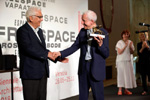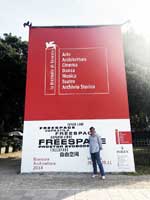
|

|
|
Home Site Search Contact Us Subscribe
|
|
"Freespace"... The One Word of the 2018 Venice Biennale, the 16th Exhibition of Architecture A survey of just 10 of the 65 national pavilions chosen for their translation of "Freespace" - and in no particular order other than my own itinerary. By Johannes M. P. Knoops, Assoc. AIA, FAAR June 7, 2018 As Kenneth Frampton pointed out in his acceptance of the 2018 Biennale Golden Lion for Lifetime Achievement, Freespace had previously been known as two words, but his stated admiration for how the Irish use English has him embracing the term. Yvonne Farrell and Shelley McNamara, of Dublin-based Grafton Architects, are the curators of this year’s Biennale. Together they crafted a multi-faceted manifesto that reads well:
To summarize, Freespace is a generous space in its programmatic ambitions, loaded with monetary, psychological, and social freedoms&hellipunsegregated space with the potential to “bind past, present, and future together.” While anticipating a wide range of translations, the diverse results may have exceeded the curators’ expectations.
This is my survey of just 10 of the 65 national pavilions. Chosen for their translation of Freespace – and in no particular order other than my own itinerary:
Saudi Arabia – “Spaces in Between” Location: Arsenale Curators: Jawaher Al-Sudairy and Dr. Sumaya Al-Solaiman
Making its debut appearance at the Architecture Biennale, Saudi Arabia constructed a layered and immersive environment. Both tactile and challenging, the work illustrates the fragmented nature of the country’s development while expressing a desire to knit both the architectural and social fabric back together. Needing to combat vacant lots that pockmark city centers rather than promoting sprawling development, the installation is a call for the basic poetics of urbanism with walkable city centers.
Argentina – “Vertigo Horizontal” Location: Arsenale Curators: Javier Mendiondo, Pablo Anzilutti, Francisco Garrido, and Federico Cairoli
A 23-meter-long mirrored terrarium provides an infinite Pampas landscape as a metaphor for an infinite Argentine “thought-scape.” To articulate the meaning of this captivating topography, sketches of spatially democratic projects are included, such as proposals for parks and social infrastructure. Since returning to a democratic government in 1983, one can sense future potentials expressed in this lush installation.
Finland – “Mind Building” Location: Giardini, Pavilion of Finland Curator: Anni Vartola
This year, the Finns transformed their Alvar Aalto pavilion into a library archiving the development of public libraries in their own country. This pavilion not only catalogues the past, but also projects a future with the much-anticipated Helsinki Central Library, designed by Helsinki-based ALA Architects, scheduled to open before the year is out. In the curators’ words: “The public library is the ultimate freespace: a publicly funded place of learning that is open for everyone, for free.” I admire immensely the sincere pride in this moral obligation that all progressive countries share.
Israel – “In Statu Quo: Architecture of Negotiation” Location: Giardini, Pavilion of Israel Curators: Ifat Finkelman, Deborah Pinto Fdeda, Tania Coen-Uzzielli, and Oren Sagiv
The methodical study “In Statu Quo” is exemplified through five sacred sites in Israel: the Church of the Holy Sepulcher, the Western Wall, the Ascent of Mughrabi to the Temple Mount, the Tomb of Rachel, and the Cave of the Patriarchs. The territorial disputes and spiritual agendas of these five sites are weighed, while ultimately suggesting that architecture is the tool by which to resolve these encrusted conflicts. Visually and intellectually rich, this installation deserves much consideration.
Russia – “Station Russia” Location: Giardini, Pavilion of Russia Curator: Semyon Mikhailovsky
Here, the pavilion has been transformed into yet another public space: a train station, including a locker room inhabited with lost and found artifacts behind its many doors. This is a delightful journey through an often-overlooked system of infrastructure. While celebrating this lifeblood of Russia’s vast terrain, the past and present are explored, while projecting us into the future with a proposed high-speed rail to connect Moscow and Kazan.
Greece – “The School of Athens” Location: Giardini, Pavilion of Greece Curators: Xristina Argyros and Ryan Neiheiser
Here, the communal spaces within universities are examined as “Freespaces.” The students of the National Technical University of Athens and the Architectural Association in London dissected iconic university buildings to extract the common spaces, which are then held up for examination. The pavilion interior itself is transformed into a stepped academic commons to foster discourse as 56 3D printed models dot its landscape. One can try their hand at identifying the various specimens; perhaps you can identify Boulée’s 1785 vision for a French national library, Yale’s Art + Architecture Building or perhaps 41 Cooper Square, Cooper Union. To add to the sense of play at hand, a model of the pavilion’s own interior is included amongst the others.
Egypt – “Roba becciah: the informal city” Location: Giardini, Pavilion of Egypt Curators: Islam El Mashtooly, Islam El Mashtooly, and Cristiano Luchetti
Intellectually perverse, this pavilion examines the possible normalization of illegally occupied space by junk peddlers. It illustrates how individuals have pirated communal public space, a polemic that dates back to antiquity. We are asked to rethink the governance of public space while suggesting the provision for spontaneous commercial interests through a governed infrastructure. This provocation yearns for some hashing out, but is, indeed, ripe for architectural response.
China – “Building a Future Countryside” Location: Arsenale Curator: Li Xiangning
Sounding like an opportunist strategy to develop China beyond its mega urban centers, the curator sees the countryside as a Freespace to develop through urbanization without romancing the past. I instead saw a more sophisticated strategy at work. In my eyes the work reflected a mature respect for existing architectural fabric. A number of projects illustrate how these talented architects took cues from the existing formal language to posit new pieces into the landscape, each with a clear sense of scale.
Scotland – “Happenstance” Location: Palazzo Zenobia Curators: WAVEparticle (Peter McCaughey, Lead Curator)
Inhabiting the gardens at Palazzo Zenobia, Happenstance also celebrates Scotland’s Year of Young People. Here, Freespace is a spatial construct of the young, as the necessity of play is examined by a variety of architects and artists. Films, talks, and workshops weave through the pavilion over the course of its occupation of Palazzo Zenobia. To serve as an armature, participants constructed a spunky wood path/tunnel/bridge to formally express their agenda.
Germany – “Unbuilding Walls” Location: Giardini, Pavilion of Germany Curators: GRAFT and Marianne Birthler
Twenty-eight years since Germany’s reunification, matching the 28 years the Berlin Wall stood, this pavilion exhibits 28 exemplars of re-occupying border voids around the world. The installation conveys a sense of gravitas as a series of black walls peel up from the floor. A number of videos resulting from an extensive global investigation of boundaries, segregation, and nationalism inhabit the walls. Potent and timely, no American should skip this one.
Switzerland – “House Tour” Location: Giardini, Pavilion of Switzerland Curators: Alessandro Bosshard, Li Tavor, Matthew van der Ploeg, and Ani Vihervaara curators.
As for the word “Freespace,” it was ironically not present in the pavilion that takes home the 2018 Golden Lion for Best National Representation. Nonetheless, the Swiss presented a fascinating manifestation of distorted domestic scale. I suggest you experience “Svizzera 240: House Tour” of your own Freewill.
Motivated by issues of memory and place Johannes Knoops, Assoc. AIA, FAAR, explores hidden urban narratives. As a tenured Associate Professor of Interior Design at FIT/SUNY, he shares his passion for a design to communicate meaning. In addition to his teaching, Knoops maintains a multi-disciplinary practice on Manhattan’s Lower East Side.
Also by Knoops:
Kenneth Frampton, a New York Lion ... now a Golden Lion of the Venice Architecture Biennale As the Ware Professor at the Columbia University Graduate School of Architecture, Planning and Preservation, where he has taught since 1972, he has shaped more than one generation of architects. (2018)
More Heart and Soul than Ever Before:
15th Venice Architecture Biennale "Reporting from the Front"
The Great Compilation: 14th International
Exhibition of Architecture di la Biennale di Venezia |
(click on pictures to enlarge)  Johannes Knoops Saudi Arabia – “Spaces in Between”  Johannes Knoops Argentina – “Vertigo Horizontal”  Johannes Knoops Finland – “Mind Building”  Johannes Knoops Israel – “In Statu Quo: Architecture of Negotiation”  Johannes Knoops Russia – “Station Russia”  Johannes Knoops Greece – “The School of Athens”  Johannes Knoops Egypt – “Roba becciah: the informal city”  Johannes Knoops China – “Building a Future Countryside”  Johannes Knoops China – “Building a Future Countryside”  Johannes Knoops Scotland – “Happenstance”  Johannes Knoops Germany – “Unbuilding Walls”  Johannes Knoops Switzerland – “House Tour”  Courtesy of La Biennale di Venezia Paolo Baratta, President of La Biennale di Venezia, with Kenneth Frampton at the 2018 Biennale Golden Lion for Lifetime Achievement ceremony.  Courtesy Johannes Knoops Johannes Knoops in Venice |
© 2018 ArchNewsNow.com